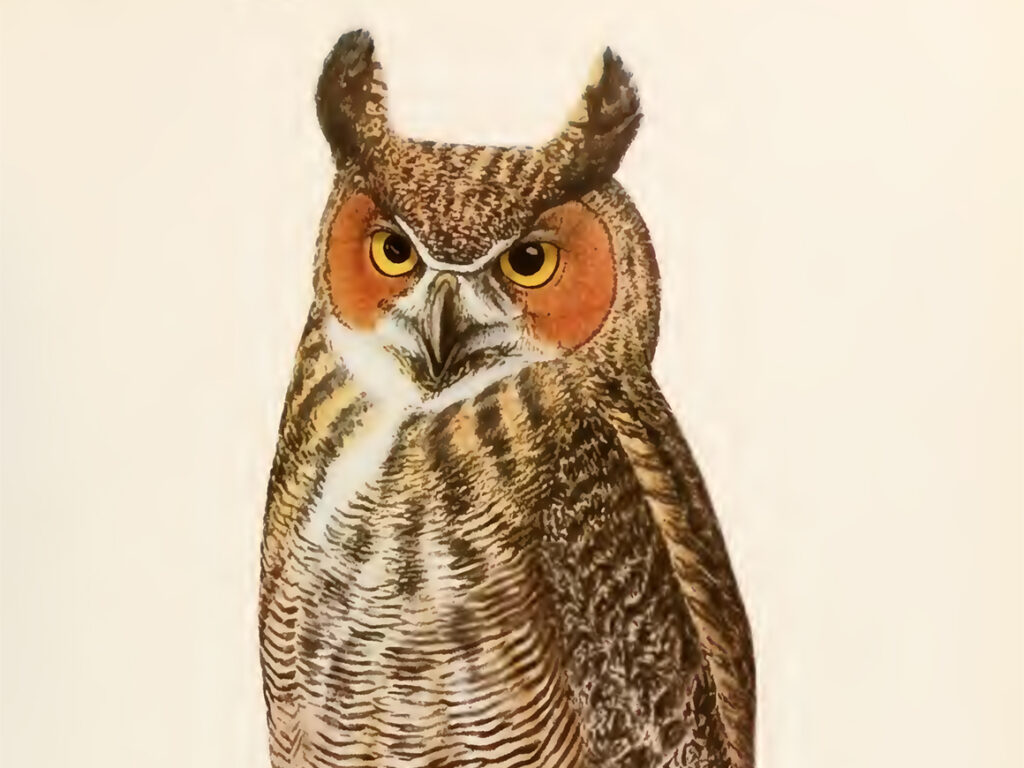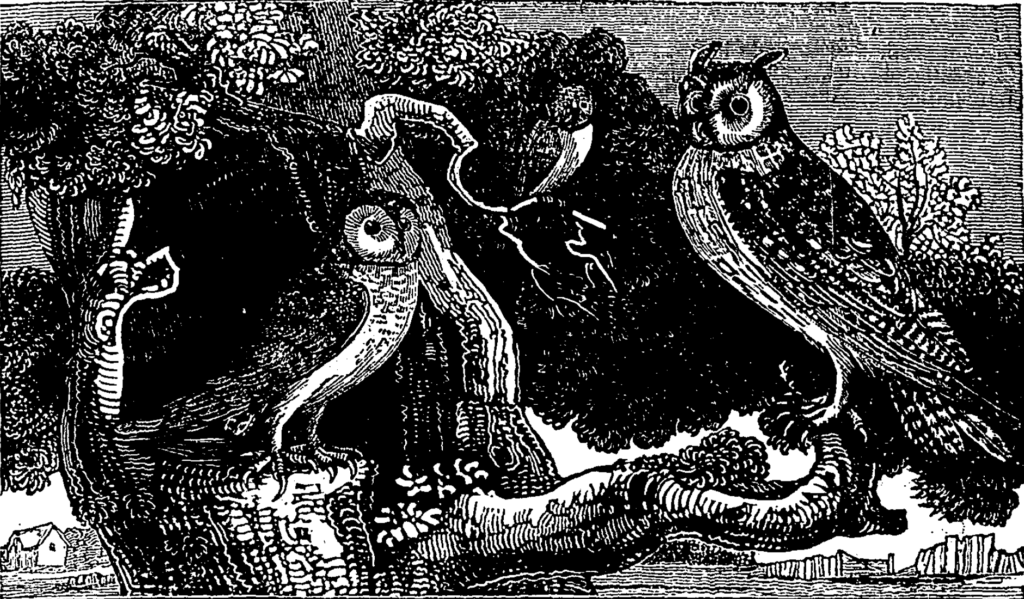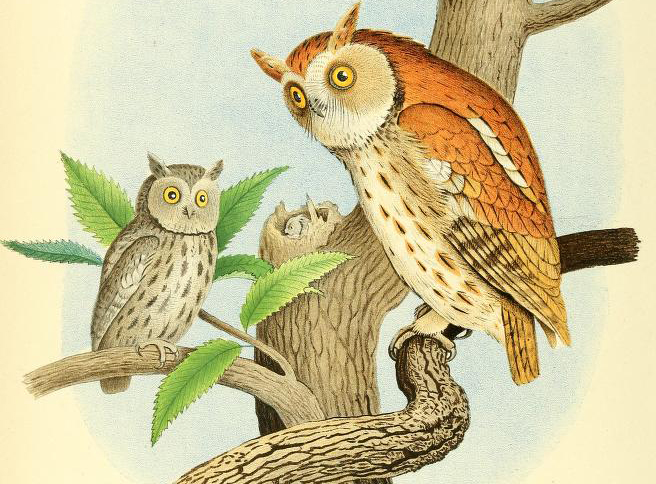The Old Owl
By Samuel Griswold Goodrich
Annotations by Karen L. Kilcup

I.
The owl is a bird that flaps along
With a lonely loud halloo;
He has but one unceasing song,
To whit, to whit, to woo:
In dusky light he takes his flight,
The twilight dim is the time for him,
And when the midnight scowls,--
'Tis then he silently prowls,
And hunts the mice and moles.
II.
A lonely owl once built her nest
In the hole of a hollow tree,
And she with a fine young brood was blest
As ever owl could be.
She loved her young, and as they clung
Beneath her downy wing,
She o'er them oft, on a branch aloft,
As they reposed below,
Would shout and sing, while the woods would ring,
To whit, to whit, to woo:
III.
A boy came by that hollow tree,
With a fierce and wild halloo;
And this the birds, all startled heard,
And answered, to whit, to woo.
As the old bird shrieked, the young ones squeaked;
"Oh ho!" said the boy,
In a frantic joy,
"An owl is the bird for me,
And here are its young ones three."
The with eager look,
He that bird's nest took;
While plaintive and low,
Rose a note of wo
From the owl in its hollow tree. [1]
To whit, to whit, to woo:

IV.
That boy now took his victims home,
And put them in a cage;
And cooped up there,
In their despair,
They bit and scratched in rage;
They caught his fingers once or twice,
And made him scream with pain;
And then he vowed,
In curses loud,
That they should all be slain.
He tied them to a stake, and got
An iron pin, and made it hot,
To burn out their young eyes.
"Ha, ha!" said he, "you'll not bite me,
You'll not bite me again:"
Then in the sky
A wing flapped by
That seemed to stop his breath;
'Twas the old owl, with a heavy scowl,
Lamenting her young ones' death--
To whit, to whit, to woo:
V.
That boy grew up--became a man,
A cruel man was he,
His heart had grown as hard as stone,
Which none but God could see.
One dreary night,
In the wan moonlight,
Beneath that hollow tree
He vengeful stood, to spill the blood
Of a hated enemy.
With a furious blow, he laid him low,
Then plunged his knife
To take his life,
Deep to its haft,
And wildly laughed,--
"You will not again plague me."
But yet as he knelt
O'er that foe, he felt
A shudder that quailed all his blood's full glow;
For oh, he heard,
On the tree that bird,
The same old owl, o'er that murder foul,
Cry, whit, to whit, to woo.
VI.
He fled--the owl's reproaching cry
Still ringing in his ears;
But ah, 'twas vain for the wretch to fly,
So loaded with guilt and fears.
He quick was caught,
And to justice brought,
And soon in prison lies.
And oh, while there,
In his deep despair,
In lonely tears and sighs,
He thought of the iron cage!
And he thought of the cruel rage!!
And the red-hot pin, that he once thrust in,
To burn out the young bird's eyes.
Condemned to die--'twas his destiny
To die on that hollow tree,
And there as he hung,
And there as he swung
In the night-wind to and fro,
That vengeful bird
Was often heard,
When scarcely a breath the forest stirred,
In screamings high,
All the night to cry,
To whit, to whit, to woo.
To whit, to whit, to woo.
SAMUEL GRISWOLD GOODRICH, “THE OLD OWL,” ROBERT MERRY’S MUSEUM 5, NO. 3 (MARCH 1843): 83-84.
[1] The image of the owl that accompanies this poem suggests that the author imagines a Great Horned Owl. These owls typically nest in “trees such as cottonwood, juniper, beech, pine, and others.” (All About Birds)

Illustrated by Thomas G. Gentry, 1882, Plate XXXIII.
Contexts
This poem—and many texts like it—express the common nineteenth-century belief that boys were more likely than girls to engage in acts of animal cruelty. “The Old Owl” also mirrors the continuing belief that (as Brigitte Fielder comments), “animal cruelty . . . might easily slip into violence toward humans” (493). When this poem was published, neither the American Society for the Prevention of Cruelty to Animals (ASPCA) nor the New York Society for the Prevention of Cruelty to Children, the earliest U.S.-based animal- and child-protection organizations, had yet been founded. Coalescing in 1866 and 1875 respectively, many activists worked on establishing both organizations. Known as “The Great Meddler,” New Yorker Henry Bergh was inspired to found the ASPCA after he witnessed a carriage driver beating a horse that had fallen in the street. Bergh modeled the organization after the UK’s Royal Society for the Prevention of Cruelty to Animals, which was founded in 1840. Among his actions was creating a “Declaration of the Rights of Animals” that he modeled on the United States Declaration of Independence.
Resources for Further Study
“All About Birds.” The Cornell Lab.
Fielder, Brigitte. “Animal Humanism: Race, Species, and Affective Kinship in Nineteenth-Century Abolitionism.” American Quarterly 65, no. 3 (September 2013): 457-514.
“History.” The New York Society for the Prevention of Cruelty to Children.
“History of the ASPCA.” ASPCA.
Kilcup, Karen L. Stronger, Truer, Bolder: American Children’s Writing, Nature, and the Environment. Athens: University of Georgia Press, 2021. Chapter two discusses the poem; chapter three briefly discusses the interlocking history of animal welfare and child welfare movements.
Pedagogy
Claudia Khourey-Bowers at Kent State University has an extensive website focusing on teaching methods on Animal Rights and Welfare. This site is hosted by Teach the Earth, a site managed by the National Association of Geoscience Teachers.
The Cornell Lab of Ornithology’s website, allaboutbirds.org, has among the best resources for teaching and learning about birds, with information on habitat, migration, feeding, life history, and sounds. It has a dedicated page for K-12 education on Teaching Bird ID.
The National Humane Education Society has a site devoted to Animal Welfare . . . in Schools! This site has numerous links to materials for teachers. The NHES offers free “Kindness in the Classroom” humane education presentations to schools for K-5 grades.
PETA sponsors TeachKind, led by “former classroom teachers, here to help schools, educators, and parents promote compassion for animals through free lessons, virtual classroom presentations, materials, advice, online resources, and more.”
Contemporary Connections
“The Old Owl” depicts cruelty in terms that most readers today will find shockingly explicit. PETA (People for the Ethical Treatment of Animals) uses some graphic images on its website to convey many instances of animal cruelty. It investigates such issues as factory farming and the use of animals in medical experiments. The organization has formed an activist movement for people 24 or younger, Students Opposing Speciesism.